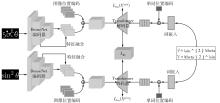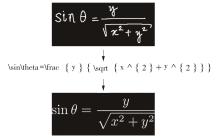| 1 |
MOUCHERE H, GAUDIN C V, ZANIBBI R,et al .ICFHR 2016 CROHME:competition on recognition of online handwritten mathematical expressions[C]∥Proceedings of the 2016 15th International Conference on Frontiers in Handwriting Recognition (ICFHR).Shenzhen:IEEE,2017:607-612.
|
| 2 |
靳简明,江红英,王庆人 .数学公式图像处理综述 [J].模式识别与人工智能,2005,18(4):429-440.
|
|
JIN Jian-ming, JIANG Hong-ying, WANG Qing-ren .Survey of mathematical expression image processing[J].Pattern Recognition and Artificial Intelligence,2005,18(4):429-440.
|
| 3 |
SIMISTIRA F, PAPAVASSILIOU V, KATSOUROS V,et al .Recognition of spatial relations in mathematical formulas[C]∥Proceedings of the 2014 14th International Conference on Frontiers in Handwriting Recognition (ICFHR).Hersonissos:IEEE,2014:164-168.
|
| 4 |
NAZEMI A, TAVAKOLIAN N, FITZPATRICK D,et al .Offline handwritten mathematical symbol recognition utilising deep learning [EB/OL].(2019-10-22)[2023-01-09]..
|
| 5 |
LODS A, ANQUETIL E, MACE S .Fuzzy visibility graph for structural analysis of online handwritten mathematical expressions[C]∥Proceedings of the 2019 International Conference on Document Analysis and Recognition (ICDAR).Sydney:IEEE,2019:641-646.
|
| 6 |
LAVANYA K, BAJAJ S, TANK P,et al .Handwritten digit recognition using hoeffding tree,decision tree and random forests—a comparative approach[C]∥Proceedings of the 2017 International Conference on Computational Intelligence in Data Science (ICCIDS).Chennai:IEEE,2017:1-6.
|
| 7 |
ALTAN A, KARASU S,ZIO E .A new hybrid model for wind speed forecasting combining long short-term memory neural network,decomposition methods and grey wolf optimizer[J].Applied Soft Computing,2021,106996/1-20.
|
| 8 |
陈路,陈道喜,陆一鸣,等 .基于注意力机制编码器-解码器的手写数学公式识别模型[J].计算机应用,2023,43(4):1297-1302.
|
|
CHEN Lu, CHEN Daoxi, LU Yiming,et al .Handwritten mathematical expression recognition model based on attention mechanism and encoder-decoder[J].Journal of Computer Applications,2023,43(4):1297-1302.
|
| 9 |
ZHANG J, DU J, ZHANG S L,et al .Watch,attend and parse:an end-to-end neural network based approach to handwritten mathematical expression recognition [J].Pattern Recognition,2017,71:196-206.
|
| 10 |
ZHANG J S, DU J, DAI L R .A GRU-based encoder-decoder approach with attention for online handwritten mathematical expression recognition[C]∥Proceedings of the 2017 14th IAPR International Conference on Document Analysis and Recognition (ICDAR).Kyoto:IEEE,2017:902-907.
|
| 11 |
ZHANG J S, DU J, DAI L R .Multi-scale attention with dense encoder for handwritten mathematical expression recognition[C]∥Proceedings of the 2018 24th International Conference on Pattern Recognition (ICPR).Beijing:IEEE,2018:2245-2250.
|
| 12 |
WU J W, YIN F, ZHANG Y M,et al .Image-to-markup generation via paired adversarial learning [C]∥Proceedings of the Machine Learning and Knowledge Discovery in Databases.Cham:Springer,2018:18-34.
|
| 13 |
WU J W, YIN F, ZHANG Y M,et al .Handwritten mathematical expression recognition via paired adversarial learning[J].International Journal of Computer Vision,2020,128:2386-2401.
|
| 14 |
LE A D .Recognizing handwritten mathematical expressions via paired dual loss attention network and printed mathematical expressions[C]∥Proceedings of the 2020 IEEE/CVF Conference on Computer Vision and Pattern Recognition Workshops (CVPRW).Seattle:IEEE,2020:2413-2418.
|
| 15 |
ZHAO W Q, GAO L C, YAN Z Y,et al .Handwritten mathematical expression recognition with bidirectionally trained transformer[C]∥Proceedings of the Document Analysis and Recognition-ICDAR 2021.Cham:Springer,2021:570-584.
|
| 16 |
BIAN X H, QIN B, XIN X Z,et al .Handwritten mathematical expression recognition via attention aggregation based bi-directional mutual learning[EB/OL].(2022-09-04)[2023-01-03]..
|
| 17 |
ZHANG Y, XIANG T, HOSPEDALES T M,et al .Deep mutual learning[C]∥Proceedings of the IEEE Conference on Computer Vision and Pattern Recognition (CVPR).New York:IEEE,2018:4320-4328.
|
| 18 |
付鹏斌,李建君,杨惠荣 .基于粘连符号分割和多特征融合的手写公式识别[J].北京工业大学学报,2021,47(8):842-853.
|
|
FU Pengbin, LI Jianjun, YANG Huirong. Handwritten formula recognition based on segmentation of adhesive symbols and multi-feature fusion[J].Journal of Beijing University of Technology,2021,47(8):842-853.
|
| 19 |
HUANG G, LIU Z, MAATEN V,et al .Densely connected convolutional networks[C]∥Proceedings of the 2017 IEEE Conference on Computer Vision and Pattern Recognition (CVPR).Honolulu:IEEE,2017:2261-2269.
|
| 20 |
VASWANI A, SHAZEER N, PARMAR N,et al .Attention is all you need[EB/OL].(2021-01-23)[2023-01-16]..
|
| 21 |
ZHAO W Q, GAO L C. CoMER:modeling coverage for transformer-based handwritten mathematical expression recognition [EB/OL].(2022-07-13)[2023-01-15]..
|
| 22 |
CARION N, MASSA F, SYNNAEVE G,et al .End-to-end object detection with transformers[C]∥Proceedings of the 16th European Conference on Computer Vision.Glasgow:Springer,2020:213-229.
|
| 23 |
DENG Y T, KANERVISTO A, LING J,et al .Image-to-markup generation with coarse-to-fine attention[C]∥Proceedings of the 34th International Conference on Machine Learning.[S.l.]:JMLR,2016:980-989.
|
| 24 |
HINTON G, VINYALS O, DEAN J .Distilling the knowledge in a neural network[EB/OL].(2018-08-13)[2023-01-15]..
|
| 25 |
ZHANG J S, DU J, YANG Y X,et al .A tree-structured decoder for image-to-markup generation[C]∥Proceedings of the International Conference on Machine Learning (ICML).[S.l.]:PMLR,2020:11076-11085.
|
| 26 |
YUAN Y, LIU X, DIKUBAB W,et al .Syntax-aware network for handwritten mathematical expression recognition[EB/OL].(2022-06-18)[2023-02-01]..
|
















